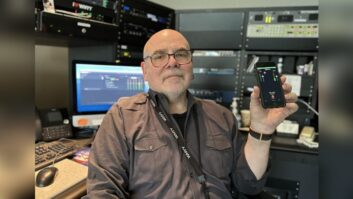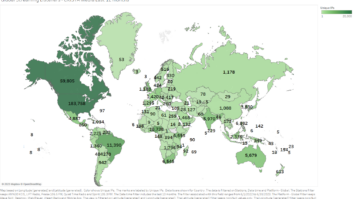After Adding Major League Baseball to Its Lineup, XM Needed Remote Setups for Game Commentary
(click thumbnail)
WASHINGTON Last fall, XM Satellite Radio announced an 11-year agreement with Major League Baseball as the exclusive satellite provider of MLB games and other programming. Until this point, the vast majority of XM remotes were live musical events, and a technician supported every broadcast. Now, however, our challenge has become designing and installing remote equipment in the homes of the MLB talent, who host live daily talk shows on XM Home Plate Channel 175.
Further, we needed to design a system that was rugged and reliable, and needed little attention. Because XM technicians are located in Washington, any failure would require the talent to work with a tech to determine the faulty device that would need to be swapped out. We would then, in all but the most extreme circumstances, ship overnight a replacement to be swapped by the talent.
As all of the installations are for a single talent, there was no need for a full-blown mixer, and several good reasons why a mixer would not be desirable in this situation. Our search led us to the Studio Technologies Model 200-Series announcer’s consoles.
Features and specs
While the majority of customers will use their announcer’s consoles for live sports remotes, we saw a piece of gear that was flexible enough to meet the requirements for our application.
The console specifications were well within our desired parameters. The low-noise microphone preamp has adjustable gain from +20 dB to +60 dB, in 10 dB steps, and can supply 48V phantom power to the microphone. There also is processing to provide a bit of “gain riding” for the microphone.
With a compression ratio of 5:1, and attack and release times of 2 ms and 100 ms respectively, the Model 230 can handle the occasional outburst of excitement that sportscasters sometimes must express vocally.
Features on the Model 200-Series include connections for IFB and intercom systems, headphone output and an auxiliary relay. A unique feature is the ability to configure the units for their specific task. There are four operating modes on the Model 230, each designed for different requirements.
The main output button can be set to mute when pressed (cough button), to mute unless pressed, to alternately latch on or off for each press or a hybrid mode which allows both push-to-talk and alternate latching. Status LEDs give a constant visual indication of the state of the console. There are many other configuration options for the talkback output, and the cue sources for the talent.
A picture diagram is located on the bottom of the cover plate for the unit, and it shows the location of the configuration dip switches, the switch function and other operating information, which comes in handy in the field.
There are many ways to power the Model 230. One is by using the supplied 24 Vdc transformer. Another is by utilizing the voltage from a “wet” intercom or IFB connection. Or, all of these can be present simultaneously, because of the internal switching power supply that regulates the operating power for the Model 230.
Level balance adjustment
We purchased four of the Model 230s and installed them. The initial feedback exposed a problem that could potentially have made us seek another solution. The problem was that the talent could not hear themselves through their headset. We were able to work around this problem by adding a “Y” cable to split the line-level output of the mic preamp, sending one output back to an IFB input, and the other output to the transmission equipment.
But this created another problem. The level balance between the talent mic and the mix-minus from Washington could not be adjusted to the satisfaction of any of the MLB talent.
After further reading in the user’s manual, I decided to e-mail Studio Technologies and explain our circumstances, in the hopes that they could help with our problem. I suggested adding an optional mode that would provide local sidetone to the headset output, and configure the two volume control knobs so that one would control only the mix-minus headset level, and the other would control the local sidetone level. This way, the talent could adjust the mix ratio that they hear in their headsets to their own individual taste.
I got a reply the next day, and I had revised software the next week with all the features I requested, which are now standard in the Model 230.
We purchased additional 230s so that we could swap out the units deployed in the field, keep units in stock as spares and have some on hand for future needs. As each 230 was swapped out for units with the new software, it was evident that the talent were pleased with the changes from the previous version. We no longer get complaints from the talent, which was one of the biggest design goals: Put it in, and forget about it.
So far, the 230s have been trouble-free, and considering how well they are built, we expect them to continue operating as such.
Most engineers who have worked on remote broadcasts envision an all-in-one command station for the announcer’s audio needs. With four versions to choose from, Studio Technologies has built the box for you.
The Model 230 retails for $1,095.
For more information, contact Studio Technologies in Illinois at (847) 676-9177 or visit www.studio-tech.com.













